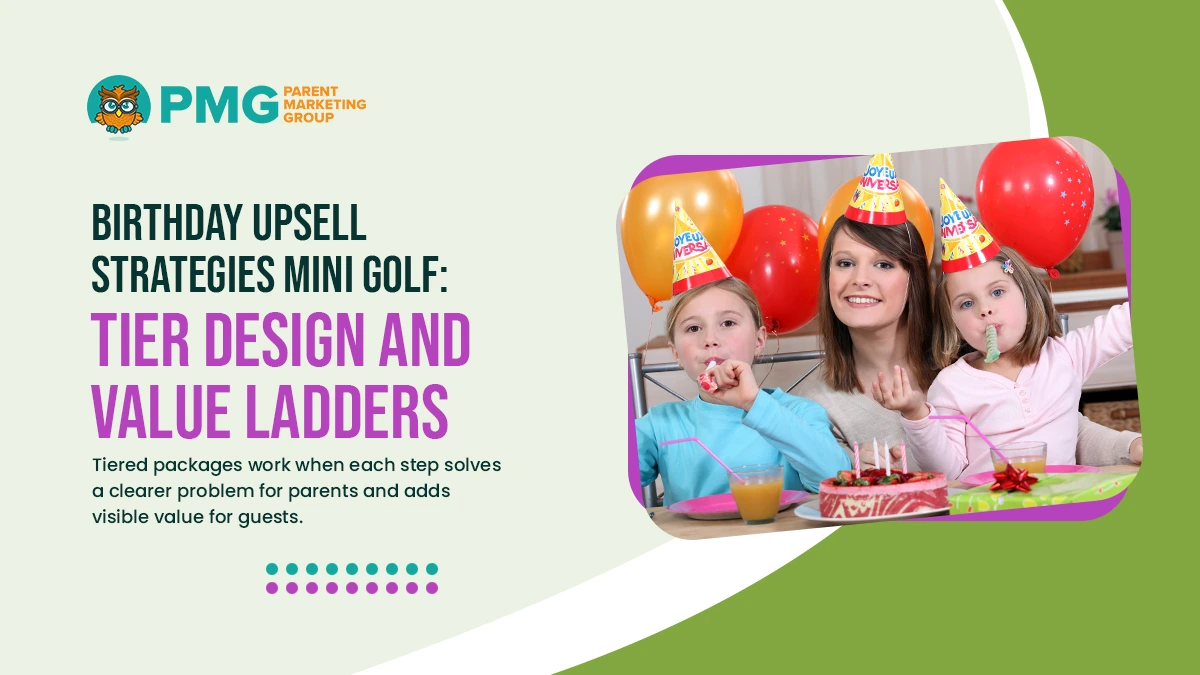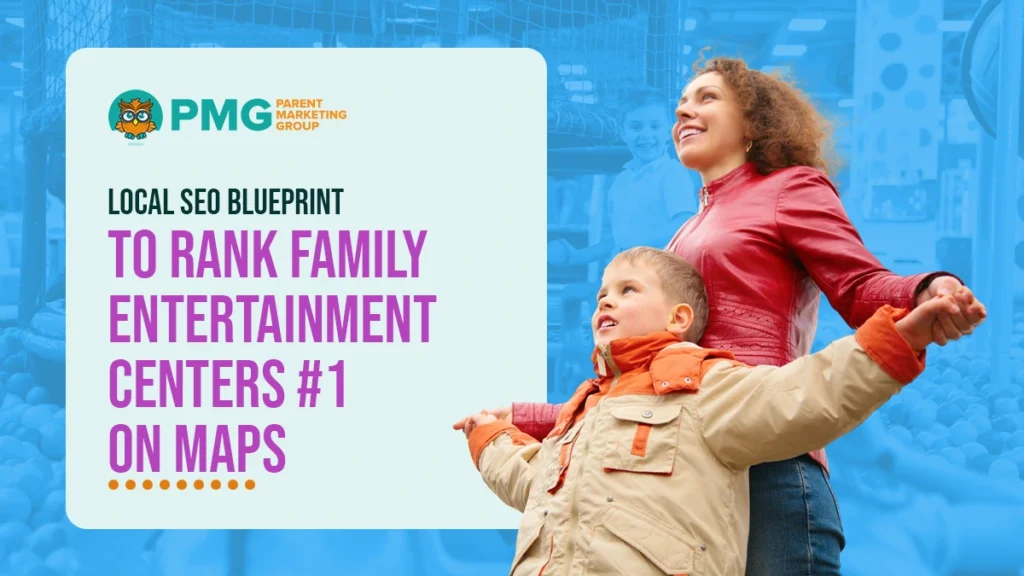Mini golf tiered party packages give parents simple, side-by-side options that raise bookings and average order value. A three-tier structure clarifies benefits at a glance, with each step adding course time, a dedicated host, reserved seating, and food and beverage bundles. Transparent per-guest pricing, deposit rules, rain plans, and digital waivers remove friction before checkout.
Tiers should map to standard group sizes and planning windows so families can self-select without back-and-forth. Connect packages to your booking engine and POS to automate add-ons, manage inventory, and speed check-in. Track conversion, deposit rate, and average order value by tier, then refine inclusions and copy to maximize party revenue.
Birthday Upsell Strategies Mini Golf: Tier Design and Value Ladders

Tiered packages work when each step solves a clearer problem for parents and adds visible value for guests. Start with a simple three-tier ladder and make the jumps unmistakable at a glance.
Name, Position, and Price Each Tier
Give every tier a role and price fence so families self-select without friction. Keep names consistent across web, phone, and on-site materials.
- Basic (Value Anchor): Entry package that secures time on the course and a reserved table.
- Deluxe (Most Popular): Adds a party host, extended course time, and bundled food and beverage.
- Ultimate (All-Inclusive): Includes premium décor, priority start times, and enhanced photo moments.
Close with clear per-guest pricing and a deposit policy. Parents should see how each rung saves time and coordination effort.
Design Clear Value Jumps
The upgrade must feel practical, not ornamental. Map inclusions to common pain points such as setup, food, and pacing between activities.
- Time and Access: Longer play windows, expedited check-in, and reserved photo spots on the course.
- Hosted Experience: A dedicated host to manage timing, groups, and transitions to cake and gifts.
- Food and Beverage: Tiered bundles with pitchers, pizza, and cupcakes sized to typical headcounts.
- Keepsakes and Décor: Branded balls, medals, and table décor that are prepared before arrival.
Each tier should be summarized with two or three benefits tied to outcomes: smoother flow, less waiting, and happier guests.
Use Behavioral Pricing Cues Ethically
Clarify value rather than pushing the highest price to help families make confident decisions. Present tiers side by side, and keep copy concise.
- Anchoring: Show Basic as a reference to make Deluxe feel like a strong value.
- Decoy Assist: A narrow mid-tier can steer buyers to a higher-value Deluxe without pressure.
- “Most Popular” Badge: Reduce choice fatigue by highlighting the option most guests select.
- Transparent Policies: Spell out deposits, reschedules, and rain plans to remove last-minute doubts.
End with a brief note on availability by season or daypart so expectations match capacity.
Measure, Learn, and Refresh
Tiers improve with data. Review weekly reports and adjust inclusions and copy to reflect actual purchase patterns.
- Upgrade Rate by Tier: Track movement from Basic to Deluxe and Deluxe to Ultimate.
- Attach Rates for Add-Ons: Identify which items lift average order value without slowing the event.
- Satisfaction Signals: Monitor reviews and post-visit surveys for setup and pacing feedback.
Refresh photos, badges, and descriptions quarterly so the ladder stays accurate and aligned with operations.
Premium Party Add-Ons Mini Golf: Menu, Merch, and Experience Bundles

Well-structured add-ons lift average order value and improve the guest experience without slowing the schedule. Organize options into clear categories so parents can customize confidently and staff can prepare efficiently.
Food and Beverage Packs
Offer scalable food choices that match common headcounts and dietary needs. Keep pricing transparent and list what is included at pickup.
- Family Pizza Bundle: Multiple pies, plates, and napkins sized to the booked party count.
- Pitchers and Refills: Lemonade, water, or soda with guaranteed refill windows.
- Cupcake Tower: Pre-set quantities with candles and serving tools for a quick celebration.
- Allergy-Friendly Options: Clearly labeled alternatives prepared in separate containers.
Confirm pickup timing on the itinerary and stage orders by party name to reduce counter congestion.
Experience Upgrades and On-Course Moments
Use experiential add-ons to make your visit feel special while preserving the pace of play. Limit each item to simple rules and clear redemption points.
- Glow Golf Upgrade: Course lighting effects are scheduled during the party’s tee time.
- VIP Start Window: Priority tee-off within a 10–15 minute window to avoid queuing.
- Extra Holes Token: A controlled replay on signature holes for the birthday guest and a friend.
- Skills Challenge + Medal: Short putting contest with a timed award photo at the finish area.
Publish where and when each upgrade is redeemed, and train hosts to cue transitions without extending room turnover.
Merchandise, Favors, and Keepsakes
Merchandise should be pre-bagged and sized by age group to speed distribution. Every item should be tied to a simple scan so inventory stays accurate.
- Branded Ball and Tee Bag: The souvenir set is packaged per guest with a label for quick handoff.
- Medal and Lanyard Set: Durable keepsake presented during the cake window or awards photo.
- Limited-Edition Visors or Wristbands: Seasonal colors photograph well and fit most guests.
- Digital Photo Pack (QR): Host-triggered gallery link delivered to the organizer after the event.
Map SKUs to the POS and booking engine, require add-ons 48 hours before the party when possible, and align stock counts with weekend forecasts to avoid substitutions.
Convert Basic to Deluxe Party: Offer Architecture and Nudges

Most parents begin with the entry package, then reconsider when the upgrade makes planning easier and the value is unmistakable. Structure the offer so the difference is clear and the path to upgrade is simple.
Design Clear Comparison Cards
Clarity drives confident choices. Present tiers side by side with concise copy and visible gains in time, service, and inclusions.
- Visible Value Difference: Show added host support, extra play time, and bundled food as concrete bullets.
- Most Popular Badge: Highlight Deluxe to reduce decision fatigue and signal a trusted choice.
- Savings Callout: Display per-guest savings versus purchasing add-ons individually.
- Policy Snapshot: Summarize the deposit, reschedule the window, and create a rain plan to remove uncertainty.
Close with a short note on availability by daypart so families match expectations to capacity.
Present Timely Upgrade Offers at Checkout
Upgrade prompts should appear when intent is highest and capacity allows it. Keep the interaction brief and reversible.
- Inline Upgrade Module: Insert a card that compares Basic vs. Deluxe above the payment.
- One-Click Price Recalc: Recompute totals immediately and preserve all guest details.
- Capacity-Aware Prompts: Offer upgrades only when rooms, food bundles, and hosts are available.
- Pre-Arrival Reminder: Send a 48-hour message with a final upgrade option tied to headcount.
Confirm the final itinerary and receipts automatically so staff preparation reflects the chosen tier.
Use Social Proof and Risk Reduction
Parents value reassurance from real experiences and predictable outcomes. Pair proof points with transparent safeguards.
- Photo Proof: Include images of Deluxe setups and reserved photo spots on the course.
- Review Snippets: Feature brief quotes that reference smoother pacing and easier hosting.
- Rain Plan Disclosure: State how the party continues or reschedules without hidden fees.
- Flexible Headcount: Offer a small adjustment window to account for last-minute changes.
These cues reduce perceived risk and encourage parents to select the option that removes work.
Recover Abandoned Carts With Gentle Nudges
When planners pause, follow up with practical information and a clear path back to the cart.
- Next-Step Email/SMS: Provide a secure link to resume at the review screen.
- Limited-Time Upgrade Credit: Offer a modest incentive that expires before the event date.
- Saved Selection Resume: Retain date, time, and guest details to avoid re-entry.
- Host Q&A Link: Answer common setup and timing questions before payment.
Track upgrade rate, average order value, and refund requests to refine copy, timing, and eligibility rules.
Package Policies and Guest Experience Foundations
Clear, guest-friendly policies set expectations and keep parties on schedule. Establish rules in plain language, surface them before checkout, and reinforce them in confirmations so families arrive prepared.
Booking Minimums, Deposits, and Changes
Policies should protect capacity while remaining fair to families. Details should be published on the package page and in every confirmation.
- Party Minimums: Set headcount and room-time minimums that reflect staffing and turnover.
- Deposits: A defined deposit amount with cutoff times is required for payment to hold inventory.
- Reschedule Window: Allow date or time moves within a clear timeframe to preserve utilization.
- Refunds or Credits: Offer standardized outcomes for cancellations to keep decisions consistent.
Summarize these terms in a brief “What to Expect” panel and link to the full policy for reference.
Weather, Safety, and Waivers
Outdoor elements and safety requirements should never be a surprise. Provide contingencies and collect waivers in advance.
- Rain Plan: Outline indoor alternatives or covered areas when rescheduling applies.
- Lightning Protocol: Specify suspension rules, monitoring, and communication steps.
- Heat/Cold Guidance: Recommend attire, hydration, and note when play may pause.
- Digital Waivers: Tie signed waivers to each participant profile for faster check-in.
Send weather updates by SMS and email when forecasts change, and display the protocol on-site.
Arrival, Timing, and Room Turnover
A predictable cadence supports smooth play and clean handoffs. Give families a timeline that matches operations.
- Arrival Window: Request arrival 15–20 minutes early for check-in and staging.
- Briefing and Staging: Allocate time for instructions, equipment fit, and group lineup.
- Buffers: Build short buffers between parties to protect room resets and photo moments.
- Cleanup Standards: Define what staff handles and what hosts manage before checkout.
Include the itinerary in confirmations, with a map, parking notes, and the meeting point.
accessibility, communication, and on-site support
Inclusive services and clear contacts reduce friction and improve satisfaction. Prepare staff and materials accordingly.
- Accessibility Options: Offer stroller-friendly paths, seating choices, and course accommodations.
- Dietary Notes: Capture allergies during booking and flag orders for kitchen prep.
- Host Ratio: Staff to a defined guest-to-host ratio for pacing and safety.
- Multilingual Materials: Provide key instructions and policies in the dominant local languages.
Share a direct on-site contact number in reminders so organizers can reach support immediately.
Conclusion
A strong tiered program does more than raise order value; it removes friction for families and creates a dependable operating rhythm for your team. When each step adds time savings, clarity, and memorable moments, parents choose confidently, and staff can run to schedule. Sustained results come from steady refinement. Keep inclusions tightly matched to real guest needs, review upgrade patterns and attach rates, and update copy and images so the value story stays obvious. Protect the experience with clear policies, prepared inventory, and trained hosts who guide pacing from arrival to the final photo.
Want a tiered party structure that consistently converts browsing into deposits? Call (716) 303-4133
or visit https://parentmarketing.com/contact-us.






